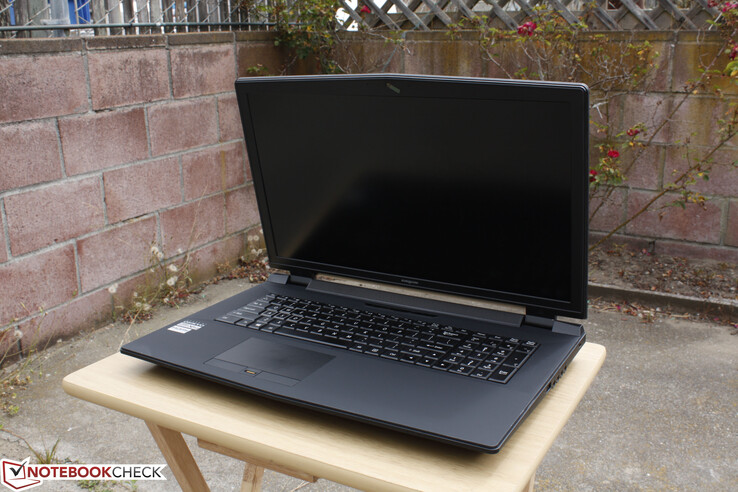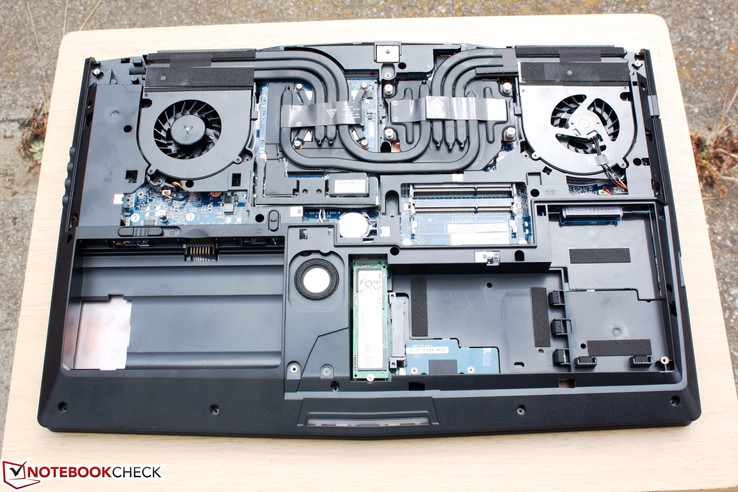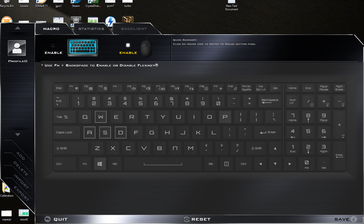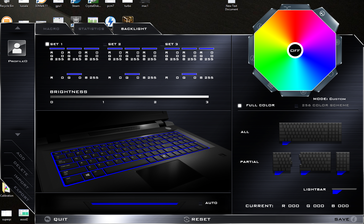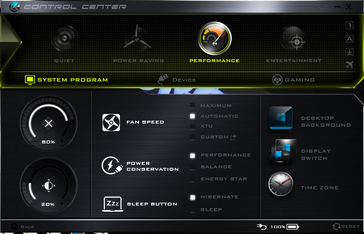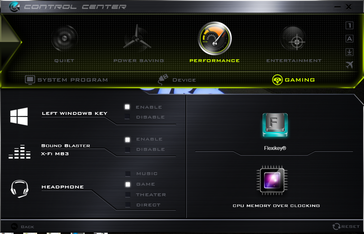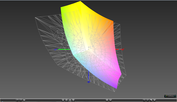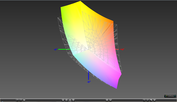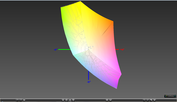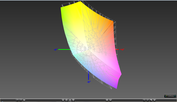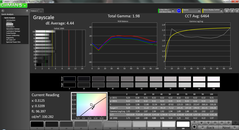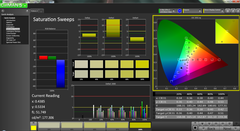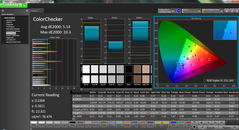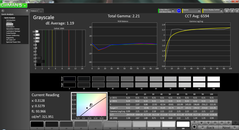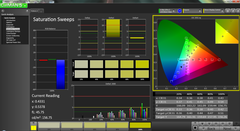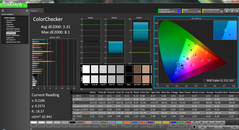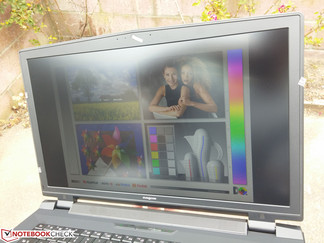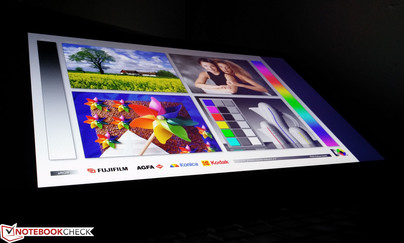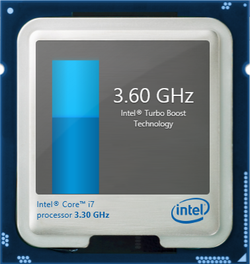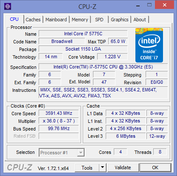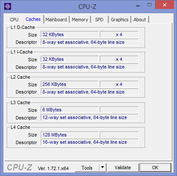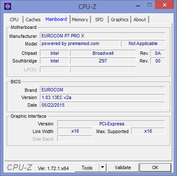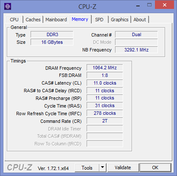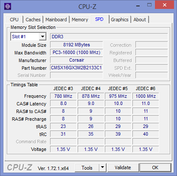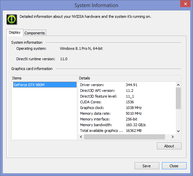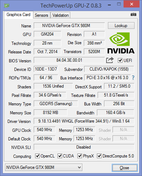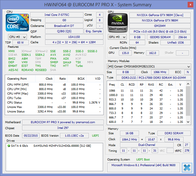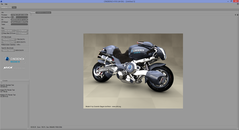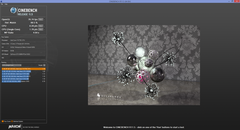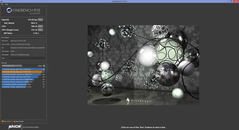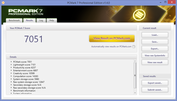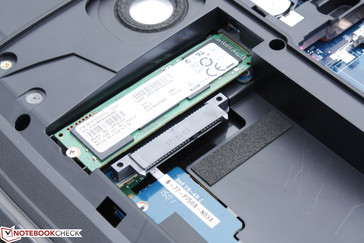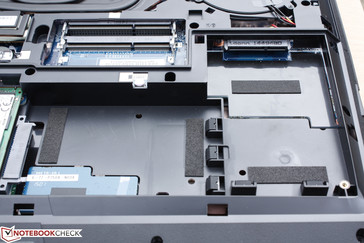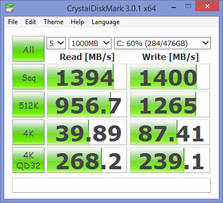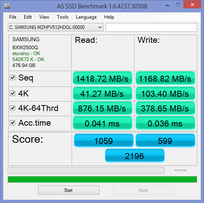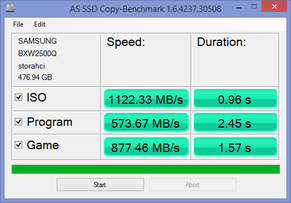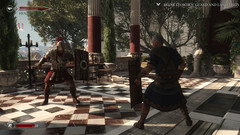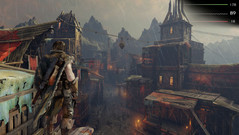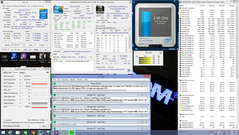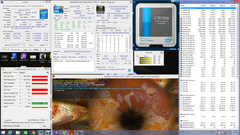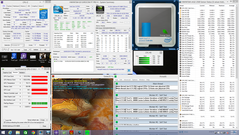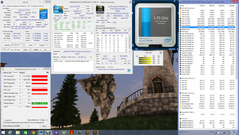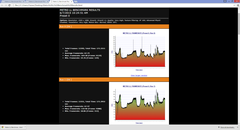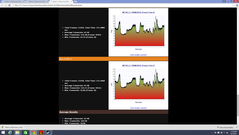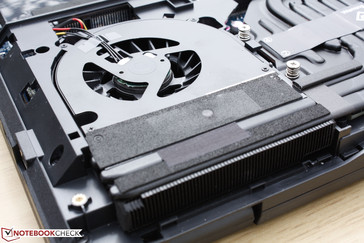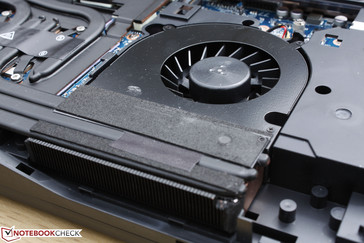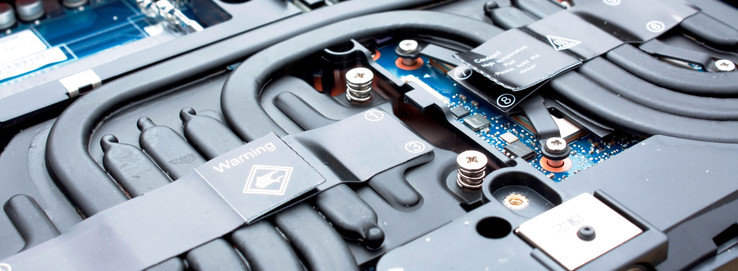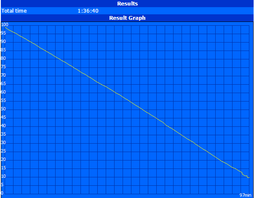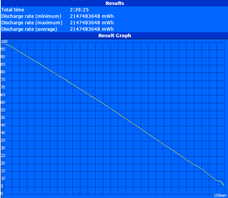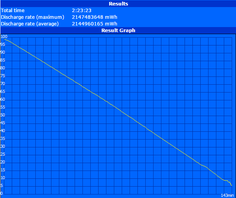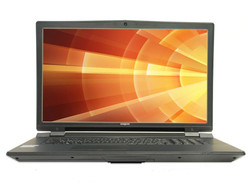Eurocom P7 Pro (Clevo P770ZM) Notebook Review
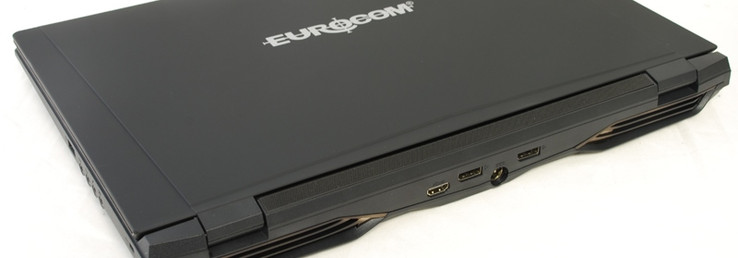
Eurocom notebooks consistently top a good chunk of our database of literally thousands of other notebooks. The Clevo barebones are not just good platforms for the fastest processors, but are also well known for their ease of accessibility and upgradeability compared to competing brands.
The 17.3-inch Eurocom P7 Pro is based off of the latest 15.6-inch Clevo P750ZM design that we covered with the Eurocom P5 Pro Extreme. As mentioned in our previous review, these systems are built to handle LGA1150 socket desktop processors with overclocking potential to boot. The end result is a performance level above even the best gaming laptops that Alienware, Asus, or MSI currently have to offer. Let's see how far we can push this premier Eurocom gaming machine.
Case
Clevo is moving away from the bulky, boxy, and boring look of its past models to something more modern, yet not too eccentric as to sacrifice any accessibility. The barebones manufacturer is still using heavy-duty ABS matte plastic to provide a more professional and rugged quality compared to aluminum alloy solutions that other gaming notebooks may use. The outer lid and palm rest surfaces are slightly rubberized for a more premium feel instead of just hard plastic. This does, however, attract fingerprints and grease much more easily. The bottom edges are tapered quite aggressively to make the notebook appear thinner than it actually is. Thus, its front edge is just 16 mm thick compared to the 38 mm rear.
Build quality is very good considering the size of the unit. The base is rigid with no twisting and no major warping when applying pressure on the center of the keyboard. The hinges are stiff up to its maximum ~135 degree angle with no rocking of the display when typing. Applying pressure on the center of the outer lid will still cause some slight warping as does twisting the display side-to-side, but the extent is largely minimal and not a cause for concern. The bezel is slightly smaller, yet it feels thicker than the thin plastic bezel of the Eurocom X7.
When compared to other popular 17.3-inch gaming notebooks, the Eurocom is thinner and smaller than both the MSI GT72 and the especially thick Asus ROG G751. A few notebooks do come in thinner, such as the Alienware 17 R2, but this Eurocom houses a much more demanding CPU and cooling system than the models listed here. In fact, the P7 Pro weighs about the same as the GT72 (3.85 kg vs 3.82 kg) despite the clear size difference between them.
Connectivity
Available ports include 5x USB 3.0 and 3x video-out options. With Optimus out of the way, users can utilize all three video-out ports for up to four displays at 3084 x 2160 resolutions. There is no built-in legacy support for VGA or a HDMI-in port. The larger Alienware models or the Asus G751 may carry some of these missing features.
Communication
WLAN includes an Intel 7265 for 802.11ac, Bluetooth 4.0, and dual-band (2x2) connectivity up to 867 Mbps as standard. A Qualcomm Killer 1525 option is also available for more gaming-centric features and optimizations. We experienced no issues with our Intel M.2 module when connecting to a home network.
Maintenance
It's no surprise that key components are easily accessible from the bottom of the unit with just a Philips screwdriver. Aside from the 2x SODIMM slots (plus 2 more under the keyboard) and 2.5-inch SATA bays, the LGA 1150 socket supports 90 Watt processors up to a Core i7-4790K and the graphics card can be swapped with another MXM 3.0b-compatible unit. The ease of upgradeability and lack of soldered components make Clevo models much more attractive compared to other gaming notebooks.
Accessories
Out-of-the-box, Eurocom throws in a Quick Start booklet and Drivers and Utilities disc. Extras screws and some thermal paste are included as well. Carrying cases, VGA adapters, and other cables are available directly from the reseller.
A 230 Watt power adapter comes standard, though users can upgrade to a larger and more powerful 330 Watt adapter.
Warranty
The usual one-year warranty applies with options to extend up to two or three years for an additional $175 or $375, respectively.
Input Devices
Keyboard
Keyboards on Clevo models have remained largely identical between generations, so the one here is similar to the one on the Eurocom X7 despite the many hardware changes underneath. Its size (35.25 x 10.75 cm) and beveled layout continue to provide firm and quiet feedback not unlike that of the Alienware 17 R2. Unlike the Asus G751 and said Alienware, however, The Eurocom lacks a set of dedicated Macro keys and must rely on combination keys for such commands. Travel is also a bit shallow and nowhere near as deep as say the mechanical keyboard on the GT80.
Its Flexikey software allows users to easily set Macro commands, input recordings, and keyboard backlight colors. The backlight functions in particular are very wide with at least 256 colors for each of the three sections of the keyboard.
Touchpad
The slightly redesigned touchpad (10.75 x 6.25 cm) is rigid with no cursor issues and a smooth glide. Synaptics V7.5 lets users customize up to three finger gestures and other sensitivity settings. The dedicated mouse keys are even quieter than the keyboard keys with a deeper travel. The feedback is a little on the soft side and certainly not as firm as it could have been. Like the rest of the notebook, fingerprints will accumulate here very quickly.
Display
The 17.3-inch 1080p panel from LG Philips offers a rated brightness of 300 nits and a contrast ratio of about 700:1. Our own measurements confirm both with an average brightness of about 319 nits and a contrast ratio just above 800:1. The display is very clean on the Eurocom with no major screen-door effect or graininess that can be common on more inexpensive notebooks. This LP173WF4-SPD1 panel can also be found on a number of other 17.3-inch gaming notebooks including the Asus GL771, MSI GT70, and MSI GE72.
Compared to competing models, the P7 Pro is just as bright with contrast to match. The display on the Alienware 17 R2 is slightly better overall in terms of color accuracy and grayscale without the need for calibration.
| |||||||||||||||||||||||||
Brightness Distribution: 88 %
Center on Battery: 335.4 cd/m²
Contrast: 873:1 (Black: 0.384 cd/m²)
ΔE ColorChecker Calman: 5.14 | ∀{0.5-29.43 Ø4.79}
ΔE Greyscale Calman: 4.44 | ∀{0.09-98 Ø5}
85.3% sRGB (Argyll 1.6.3 3D)
56.1% AdobeRGB 1998 (Argyll 1.6.3 3D)
62.4% AdobeRGB 1998 (Argyll 3D)
85.3% sRGB (Argyll 3D)
67.2% Display P3 (Argyll 3D)
Gamma: 1.98
CCT: 6464 K
| Eurocom P7 Pro | Alienware 17 R2 | Asus G751JY-T7009H | MSI GT72-2QE32SR311BW | Gigabyte P37X | |
|---|---|---|---|---|---|
| Display | -1% | -0% | -5% | 3% | |
| Display P3 Coverage (%) | 67.2 | 66.6 -1% | 66.4 -1% | 60.3 -10% | 68.7 2% |
| sRGB Coverage (%) | 85.3 | 84.3 -1% | 85.3 0% | 84 -2% | 87.9 3% |
| AdobeRGB 1998 Coverage (%) | 62.4 | 61.6 -1% | 62.1 0% | 61.4 -2% | 64 3% |
| Screen | 6% | 1% | -39% | -1% | |
| Brightness middle (cd/m²) | 335.4 | 331 -1% | 329 -2% | 273 -19% | 361.7 8% |
| Brightness (cd/m²) | 319 | 307 -4% | 326 2% | 259 -19% | 347 9% |
| Brightness Distribution (%) | 88 | 84 -5% | 93 6% | 85 -3% | 91 3% |
| Black Level * (cd/m²) | 0.384 | 0.3 22% | 0.47 -22% | 0.3 22% | 0.734 -91% |
| Contrast (:1) | 873 | 1103 26% | 700 -20% | 910 4% | 493 -44% |
| Colorchecker dE 2000 * | 5.14 | 4.88 5% | 3.95 23% | 11.63 -126% | 2.81 45% |
| Greyscale dE 2000 * | 4.44 | 3.63 18% | 3.36 24% | 11.9 -168% | 1.92 57% |
| Gamma | 1.98 111% | 2.17 101% | 2.46 89% | 2.56 86% | 2.21 100% |
| CCT | 6464 101% | 6325 103% | 5961 109% | 15491 42% | 6384 102% |
| Color Space (Percent of AdobeRGB 1998) (%) | 56.1 | 55 -2% | 56 0% | 54 -4% | 57.95 3% |
| Color Space (Percent of sRGB) (%) | 85.3 | 84.2 -1% | |||
| Total Average (Program / Settings) | 3% /
5% | 1% /
1% | -22% /
-30% | 1% /
-0% |
* ... smaller is better
Color coverage is 56 percent and 85 percent of AdobeRGB and sRGB standards, respectively. This is good for an IPS display and is very similar to both the Razer Blade Pro and Alienware 17 R2. Cheap TN panels normally cover a little more than half of sRGB and even less of AdobeRGB. Eurocom does offer other display options including glossy and 90 percent NTSC panels. No resolutions above 1080p just yet, however.
Further measurements with an X-Rite spectrophotometer reveal generally accurate grayscale and colors across the tested saturation levels. A quick calibration improves grayscale dramatically with Gamma close to the ideal 2.2 for sRGB. Orange and Yellow hues are represented less accurately compared to other colors. The less-than-perfect sRGB coverage means colors become less accurate at higher saturation where targets begin to fall beyond the color space of the Eurocom panel.
Outdoor usability is just barely above average as the backlight will need to be much more powerful for comfortable viewing. The matte panel helps, but the screen will become quickly washed out even on an overcast day. Adjusting the display angle and setting the screen to maximum brightness will definitely help.
Viewing angles are excellent as expected from an IPS panel. Colors and brightness do not dramatically degrade even if viewing from extreme angles.
Performance
The Eurocom P7 Pro is very configurable and the reseller naturally offers a wide range of high-end hardware options ranging from a Core i7-4790 to a Xeon E3-1281 and a GTX 965M to a Radeon R9 M290X. Unlocked processors are also available up to a Core i7-5775C. Our test unit is equipped with such a CPU and is one of the first notebooks to sport this particular Broadwell model.
When idling on Power Saver mode, the CPU and GPU will run at 800 MHz and 135/162 MHz core/memory, respectively. The lack of Optimus means the integrated Iris Pro Graphics 6200 is disabled in favor of raw dedicated GPU performance and the ability to utilize all video-out ports with no middleman.
RAM is supported up to 32 GB via 4x SODIMM slots. LatencyMon reports no dropout issues when wireless radios are active.
Processor
With a rated TDP of 65 W, the i7-5775C sits between the 47 W mobile i7-4980HQ and 88 W desktop i7-4790K in our Alienware 17 R2 and Eurocom P5 Pro, respectively. The smaller 14 nm die shrink and more consistent core clock rate both give the i7-5775C a small advantage over the i7-4980HQ in multi-core benchmarks by about 10 percent according to CineBench and 20 percent according to 3DMark Physics scores. Gains in single-core operations are much smaller, however, likely due to the ridiculously fast 4 GHz Turbo clock of the i7-4980HQ, which is higher than the default 3.7 GHz Turbo maximum on the i7-5775C.
The i7-4790K consistently outperforms the i7-5775C by at least 10 percent in raw CPU benchmarks like CineBench, Super Pi, and wPrime. 3DMark Physics scores are much closer to within just a few percentage points, so tangible performance gains while gaming are likely to be very marginal between these two desktop processors when paired with a GTX 980M. The very common i7-4710HQ and i7-4720HQ in almost all other high-end gaming notebooks fall behind by at least 15 percent and up to 30 percent in some cases.
| Cinebench R11.5 | |
| CPU Single 64Bit (sort by value) | |
| Eurocom P7 Pro | |
| Eurocom P5 Pro Extreme | |
| Alienware 17 R2 | |
| Asus G751JY-T7009H | |
| Gigabyte P37X | |
| CPU Multi 64Bit (sort by value) | |
| Eurocom P7 Pro | |
| Eurocom P5 Pro Extreme | |
| Alienware 17 R2 | |
| Asus G751JY-T7009H | |
| Gigabyte P37X | |
| Cinebench R10 | |
| Rendering Single CPUs 64Bit (sort by value) | |
| Eurocom P7 Pro | |
| Eurocom P5 Pro Extreme | |
| Gigabyte P37X | |
| Rendering Multiple CPUs 64Bit (sort by value) | |
| Eurocom P7 Pro | |
| Eurocom P5 Pro Extreme | |
| Gigabyte P37X | |
| wPrime 2.10 - 1024m (sort by value) | |
| Eurocom P7 Pro | |
| Eurocom P5 Pro Extreme | |
| Gigabyte P37X | |
| Super Pi Mod 1.5 XS 32M - 32M (sort by value) | |
| Eurocom P7 Pro | |
| Eurocom P5 Pro Extreme | |
| Gigabyte P37X | |
| 3DMark 11 - 1280x720 Performance Physics (sort by value) | |
| Eurocom P7 Pro | |
| Eurocom P5 Pro Extreme | |
| Alienware 17 R2 | |
| Asus G751JY-T7009H | |
| Gigabyte P37X | |
| 3DMark | |
| Fire Strike Extreme Physics (sort by value) | |
| Eurocom P7 Pro | |
| Eurocom P5 Pro Extreme | |
| Gigabyte P37X | |
| 1920x1080 Fire Strike Physics (sort by value) | |
| Eurocom P7 Pro | |
| Eurocom P5 Pro Extreme | |
| Alienware 17 R2 | |
| Asus G751JY-T7009H | |
| Gigabyte P37X | |
| 1280x720 Cloud Gate Standard Physics (sort by value) | |
| Eurocom P7 Pro | |
| Eurocom P5 Pro Extreme | |
| Alienware 17 R2 | |
| Asus G751JY-T7009H | |
| Gigabyte P37X | |
| 1920x1080 Ice Storm Extreme Physics (sort by value) | |
| Eurocom P7 Pro | |
| Eurocom P5 Pro Extreme | |
| Gigabyte P37X | |
* ... smaller is better
CPU Overclocking
Overclocking potential is vastly improved over the Core i7-4790K in our Eurocom P5 Pro Extreme. This is unsurprising given the lower TDP, lower base frequencies, and smaller lithography of the i7-5775C. We are able to overclock the CPU through the unlocked BIOS up to a steady 4.1 GHz for both single- and multi-core Turbo Boosts with great results from CineBench R15. Any higher, however, and system errors will begin creeping in before needing to alter CPU voltage to compensate. In comparison, our P5 Pro would crash from overclocking just 200 MHz above its base clock.
| Overclock Delta (Multi-core/Single-core) | CineBench R15 Multi-core score | CineBench R15 Single-core score |
| +100/0 MHz | 790 | 153 |
| +200/100 MHz | 816 | 158 |
| +300/200 MHz | 837 | 163 |
| +400/300 MHz | 854 | 165 |
| +500/400 MHz | 868 | 170 |
System Performance
The current king in our PCMark 7 database is the Eurocom Pro 5 Extreme with its final tally of 7272 points. Our P7 Pro clocks in at 7051 points, or just a couple hundred below our record holder. The high numbers can be partly attributed to the ridiculously fast PCIe x4 Samsung SSD, which also helps the notebook achieve high PCMark 8 numbers as well. Certain RAID 0 systems do score slightly higher than our Eurocom including the MSI GT72 (4x 256 GB Kingston SSDs) and larger MSI GT80 (4x 256 GB Toshiba SSDs).
| PCMark 7 Score | 7051 points | |
| PCMark 8 Home Score Accelerated v2 | 5171 points | |
| PCMark 8 Creative Score Accelerated v2 | 5747 points | |
| PCMark 8 Work Score Accelerated v2 | 5238 points | |
Help | ||
Storage Devices
A total of four storage bays are available in the form of two PCIe x4 and x2 slots and two 2.5-inch SATA III bays with RAID 0/1 support. The included 512 GB Samsung SM951 SSD and PCIe x4 slot are becoming increasingly common on high-end gaming notebooks such as the Asus UX501 and G501 as the slot provides extremely fast transfer rates. CDM shows sequential read and write rates of about 1400 MB/s, which is already faster than many RAID 0 setups and almost three times as fast as a single SATA III SSD. Nontheless, read and write rates of smaller 4K blocks aren't as wide between PCIe x4 and SATA III. Our comparison table of HDDs and SSDs can be found on our dedicated page here.
Note that the system lacks an ODD slot where a fifth HDD or SDD can normally be equipped in lieu of disc drive. It is likely that Clevo will be phasing out the optical drive slot in favor of external USB solutions.
GPU Performance
Synthetic GPU benchmark results are some of the highest we've seen for a notebook with a single graphics card. The final 3DMark 11 score of 11836 points is just a hair above the One K73-5N, which uses a fast desktop Core i7-4790K CPU paired with a GTX 980M. The Eurocom is also several hundred points higher than the Asus G751 in the same benchmark. 3DMark Fire strike scores are in the same ballpark as other high-end systems carrying GTX 980M or Radeon R9 M295X GPUs, such as in the 27-inch iMac Retina 5K.
| 3DMark 06 Standard Score | 26537 points | |
| 3DMark 11 Performance | 11836 points | |
| 3DMark Ice Storm Standard Score | 161287 points | |
| 3DMark Cloud Gate Standard Score | 26798 points | |
| 3DMark Fire Strike Score | 8514 points | |
| 3DMark Fire Strike Extreme Score | 4290 points | |
Help | ||
Gaming Performance
Our gaming benchmarks with the GTX 980M are well-documented on our dedicated GPU page. Thus, users can find additional technical information and benchmarks across a variety of notebooks sporting the high-end Nvidia GPU here.
In short, our P7 Pro performs above average compared to other GTX 980M-equipped systems due to its ability to maintain very consistent Turbo Boost and GPU Boost speeds. Nonetheless, systems with GTX 970M SLI or GTX 980M SLI graphics will still outperform the P7 Pro.
| low | med. | high | ultra | |
|---|---|---|---|---|
| Sleeping Dogs (2012) | 171.8 | 58.4 | ||
| Guild Wars 2 (2012) | 75.8 | 70.6 | ||
| Tomb Raider (2013) | 248.4 | 104.3 | ||
| StarCraft II: Heart of the Swarm (2013) | 171.5 | 111.8 | ||
| BioShock Infinite (2013) | 217.1 | 94.5 | ||
| Metro: Last Light (2013) | 124.2 | 67.9 | ||
| Thief (2014) | 78.8 | 49.8 | ||
| Middle-earth: Shadow of Mordor (2014) | 89.9 | 69.7 | ||
| Ryse: Son of Rome (2014) | 68.6 | 62.6 | ||
| F1 2014 (2014) | 120 | 120 | ||
| Dragon Age: Inquisition (2014) | 69.1 | 46.5 | ||
| Battlefield Hardline (2015) | 98 | 71.8 |
| Metro: Last Light | |
| 1920x1080 Very High (DX11) AF:16x (sort by value) | |
| Eurocom P7 Pro | |
| Eurocom X8 | |
| Aorus X7 Pro | |
| Aorus X3 Plus v3 | |
| Razer Blade Pro 17 inch 2015 | |
| 1366x768 High (DX11) AF:16x (sort by value) | |
| Eurocom P7 Pro | |
| Eurocom X8 | |
| Aorus X7 Pro | |
| Aorus X3 Plus v3 | |
| Razer Blade Pro 17 inch 2015 | |
| 1366x768 Medium (DX10) AF:4x (sort by value) | |
| Aorus X7 Pro | |
| 1024x768 Low (DX10) AF:4x (sort by value) | |
| Aorus X7 Pro | |
| Sleeping Dogs | |
| 1920x1080 Extreme Preset AA:Extreme (sort by value) | |
| Eurocom P7 Pro | |
| Eurocom X8 | |
| Aorus X3 Plus v3 | |
| Razer Blade Pro 17 inch 2015 | |
| 1366x768 High Preset AA:High (sort by value) | |
| Eurocom P7 Pro | |
| Eurocom X8 | |
| Aorus X3 Plus v3 | |
| Razer Blade Pro 17 inch 2015 | |
| Guild Wars 2 | |
| 1920x1080 All Maximum / On AA:FX (sort by value) | |
| Eurocom P7 Pro | |
| Eurocom X8 | |
| Aorus X7 Pro | |
| Aorus X3 Plus v3 | |
| Razer Blade Pro 17 inch 2015 | |
| 1366x768 Best Appearance Preset AA:FX (sort by value) | |
| Eurocom P7 Pro | |
| Eurocom X8 | |
| Aorus X7 Pro | |
| Aorus X3 Plus v3 | |
| Razer Blade Pro 17 inch 2015 | |
| 1024x768 Best Performance Preset (sort by value) | |
| Aorus X7 Pro | |
| Tomb Raider | |
| 1920x1080 Ultra Preset AA:FX AF:16x (sort by value) | |
| Eurocom P7 Pro | |
| Eurocom X8 | |
| Aorus X7 Pro | |
| Aorus X3 Plus v3 | |
| Razer Blade Pro 17 inch 2015 | |
| 1366x768 High Preset AA:FX AF:8x (sort by value) | |
| Eurocom P7 Pro | |
| Eurocom X8 | |
| Aorus X7 Pro | |
| Aorus X3 Plus v3 | |
| Razer Blade Pro 17 inch 2015 | |
| 1366x768 Normal Preset AA:FX AF:4x (sort by value) | |
| Aorus X7 Pro | |
| 1024x768 Low Preset (sort by value) | |
| Aorus X7 Pro | |
| StarCraft II: Heart of the Swarm | |
| 1920x1080 Ultra / Extreme AA:on (sort by value) | |
| Eurocom P7 Pro | |
| Eurocom X8 | |
| Aorus X3 Plus v3 | |
| Razer Blade Pro 17 inch 2015 | |
| 1366x768 High AA:on (sort by value) | |
| Eurocom P7 Pro | |
| Eurocom X8 | |
| Aorus X3 Plus v3 | |
| Razer Blade Pro 17 inch 2015 | |
| BioShock Infinite | |
| 1920x1080 Ultra Preset, DX11 (DDOF) (sort by value) | |
| Eurocom P7 Pro | |
| Eurocom X8 | |
| Aorus X7 Pro | |
| Aorus X3 Plus v3 | |
| Razer Blade Pro 17 inch 2015 | |
| 1366x768 High Preset (sort by value) | |
| Eurocom P7 Pro | |
| Eurocom X8 | |
| Aorus X7 Pro | |
| Aorus X3 Plus v3 | |
| Razer Blade Pro 17 inch 2015 | |
| 1366x768 Medium Preset (sort by value) | |
| Aorus X7 Pro | |
| 1280x720 Very Low Preset (sort by value) | |
| Aorus X7 Pro | |
| Thief | |
| 1920x1080 Very High Preset AA:FXAA & High SS AF:8x (sort by value) | |
| Eurocom P7 Pro | |
| Eurocom X8 | |
| Aorus X7 Pro | |
| Aorus X3 Plus v3 | |
| Razer Blade Pro 17 inch 2015 | |
| 1366x768 High Preset AA:FXAA & Low SS AF:4x (sort by value) | |
| Eurocom P7 Pro | |
| Eurocom X8 | |
| Aorus X7 Pro | |
| Aorus X3 Plus v3 | |
| Razer Blade Pro 17 inch 2015 | |
| 1366x768 Normal Preset AA:FX (sort by value) | |
| Aorus X7 Pro | |
| 1024x768 Very Low Preset (sort by value) | |
| Aorus X7 Pro | |
| Middle-earth: Shadow of Mordor | |
| 1920x1080 Ultra Preset (HD Package) (sort by value) | |
| Eurocom P7 Pro | |
| Aorus X7 Pro | |
| Aorus X3 Plus v3 | |
| Razer Blade Pro 17 inch 2015 | |
| 1920x1080 High Preset (sort by value) | |
| Eurocom P7 Pro | |
| Aorus X7 Pro | |
| Aorus X3 Plus v3 | |
| Razer Blade Pro 17 inch 2015 | |
| 1344x756 Medium Preset (sort by value) | |
| Aorus X7 Pro | |
| 1280x720 Lowest Preset (sort by value) | |
| Aorus X7 Pro | |
| Ryse: Son of Rome | |
| 1920x1080 Very High Texture Res. + High Graphics Quality (Motion Blur & Temporal AA On, Rest Off/Disabled) AF:8x (sort by value) | |
| Eurocom P7 Pro | |
| Eurocom X8 | |
| Aorus X7 Pro | |
| Aorus X3 Plus v3 | |
| Razer Blade Pro 17 inch 2015 | |
| 1920x1080 High Texture Res. + High Graphics Quality (Rest Off/Disabled) AF:8x (sort by value) | |
| Eurocom P7 Pro | |
| Eurocom X8 | |
| Aorus X7 Pro | |
| Aorus X3 Plus v3 | |
| Razer Blade Pro 17 inch 2015 | |
| 1366x768 Medium Texture Res. + Normal Graphics Quality (Rest Off/Disabled) AF:4x (sort by value) | |
| Aorus X7 Pro | |
| 1024x768 Low Texture Res. + Low Graphics Quality (Rest Off/Disabled) AF:2x (sort by value) | |
| Aorus X7 Pro | |
| F1 2014 | |
| 1920x1080 Ultra Preset AA:4x MS (sort by value) | |
| Eurocom P7 Pro | |
| Eurocom X8 | |
| Aorus X7 Pro | |
| Aorus X3 Plus v3 | |
| Razer Blade Pro 17 inch 2015 | |
| 1920x1080 High Preset (sort by value) | |
| Eurocom P7 Pro | |
| Eurocom X8 | |
| Aorus X7 Pro | |
| Aorus X3 Plus v3 | |
| Razer Blade Pro 17 inch 2015 | |
| 1366x768 Medium Preset (sort by value) | |
| Aorus X7 Pro | |
| 1024x768 Ultra Low Preset (sort by value) | |
| Aorus X7 Pro | |
| Dragon Age: Inquisition | |
| 1920x1080 Ultra Graphics Quality AA:2x MS (sort by value) | |
| Eurocom P7 Pro | |
| Eurocom X8 | |
| 1920x1080 High Graphics Quality (sort by value) | |
| Eurocom P7 Pro | |
| Eurocom X8 | |
| Battlefield Hardline | |
| 1920x1080 Ultra Graphics Quality (DX11) AA:4x MS (sort by value) | |
| Eurocom P7 Pro | |
| 1920x1080 High Graphics Quality (DX11) (sort by value) | |
| Eurocom P7 Pro | |
Stress Test
We stress the notebook with synthetic benchmarks to observe for any potential throttling or stability issues. With just Prime95 active, the Core i7-5775C in the Eurocom is able to maintain its maximum 3.6 GHz Turbo Boost for all four cores. The system fans will begin to operate near their maximum speeds once CPU temperature reaches 80 C. With just FurMark active, GPU core clock drops from 1037 MHz to a steady 834 to 847 MHz while memory clock remains flat at 1252 MHz.
Maximum CPU and GPU stress with both Prime95 and FurMark will cause the CPU to lose all Turbo Boost benefits after the first few minutes and remain stable in the 3.2 to 3.3 GHz range. Meanwhile, the GPU fluctuates between 810 to 835 MHz. If the Maximum Fan Speed option is enabled, then the CPU will gain back a bit of its Turbo Boost while GPU core temperature drops a few degrees. GPU temperature remains relatively low even under high stress despite the fact that it still throttles down to the 800 MHz range. A larger PSU may potentially benefit the P7 Pro in this regard.
Unigine Heaven more accurately represents gaming stress. Under these conditions, both the CPU and GPU are able to sustain high Boosts and at lower core temperatures. We also ran the Metro: Last Light benchmark ten consecutive times to observe for any drops in performance over time. The first run returned an average 67.7 FPS compared to the last run with an average of 67.4 FPS. This is very consistent, especially when compared to the GTX 980M in the thinner Gigabyte P37X under similar testing conditions.
Running on battery power will reduce both CPU and GPU performances dramatically. The CPU drops to a steady 1.9 GHz and the GPU to 670/405 MHz core/memory. A 3DMark 11 run on batteries returns Physics and Graphics scores of 5494 and 6851 points, respectively.
| Core i7-5775C CPU (MHz) | GeForce GTX 980M (MHz) | CPU Temperature (C) | GPU Temperature (C) | |
| System Idle (Power Saver) | 800 | 135 | 40 - 45 | 43 |
| Prime95 stress | 3600 | - | 75 - 80 | - |
| FurMark stress | - | 834 - 847 | - | 65 |
| Prime95 + FurMark stress | 3200 - 3300 | 810 - 835 | 90 - 95 | 76 |
| Prime95 + FurMark stress (Maximum Fan Speed) | 3400 - 3500 | 810 - 835 | 90 - 95 | 71 |
| Unigine Heaven stress | 3700 | 1113 - 1126 | 65 - 70 | 67 |
| Unigine Heaven stress (Battery Power) | 1900 | 670 | 55 | 54 |
Emissions
System Noise
Like the smaller P5 Pro, the P7 Pro utilizes a similar cooling system consisting of six large copper heat pipes and dual 60 mm fans. The sheer size and length of the pipes make the cooling system of other gaming notebooks look puny in comparison.
With such a wide heat spread, the P7 Pro is silent when browsing or watching videos on Power Saver mode as the fans do not kick in until at least medium-level loads. Once this threshold is reached, such as when gaming or running other demanding software, the system fans jump abruptly from around 29 dB(A) to 38 dB(A) with really nothing in between. Fan noise when gaming will be in the 42 to 45 dB(A) range and can be as loud as 53 dB(A) if Maximum Fan Speed is enabled.
Compared to competing models from Alienware, MSI, or Asus, the Eurocom is surprising as it is able to remain silent for longer under low to medium loads even when the High Performance profile is active. This is impressive because of the higher TDP CPU and lack of Optimus support compared to most gaming notebooks. Still, fan noise when gaming is no different from other systems with GTX 970M/980M GPUs at the mid 40 dB(A) range. The exceptions are ultrathin gaming notebooks like the Aorus X7 or Gigabyte P37X where fans are more sensitive and can be as loud as 50 dB(A).
Noise level
| Idle |
| 28.7 / 28.8 / 29.1 dB(A) |
| Load |
| 42.4 / 53 dB(A) |
 | ||
30 dB silent 40 dB(A) audible 50 dB(A) loud |
||
min: | ||
Temperature
Surface temperature characteristics are excellent given the demanding hardware. Like many high-power gaming notebooks, Clevo has concentrated most of the produced heat towards the rear of the unit and away from the palm rests and keyboard keys. This leads to a notebook that is not overly warm on the hands during even the most stressful of computing tasks. Our measurements below were taken after 30 minutes of uninterrupted full stress conditions (Prime95 + FurMark). As shown, surface temperature increases most dramatically directly above the heat pipes.
Competing models like the Asus G751 and MSI GT72 show similar surface temperature development, though the Eurocom appears to be better at keeping the keyboard area a little cooler. In comparison, the Alienware 17 R2 is notorious for having a very warm keyboard while the ultrathin Gigabyte P37X can reach higher temperatures of over 60 C on the rear of the unit.
(+) The maximum temperature on the upper side is 39.4 °C / 103 F, compared to the average of 40.5 °C / 105 F, ranging from 21.2 to 68.8 °C for the class Gaming.
(-) The bottom heats up to a maximum of 47 °C / 117 F, compared to the average of 43.3 °C / 110 F
(+) In idle usage, the average temperature for the upper side is 31.1 °C / 88 F, compared to the device average of 33.9 °C / 93 F.
(+) The palmrests and touchpad are cooler than skin temperature with a maximum of 26.6 °C / 79.9 F and are therefore cool to the touch.
(+) The average temperature of the palmrest area of similar devices was 28.9 °C / 84 F (+2.3 °C / 4.1 F).
Speakers
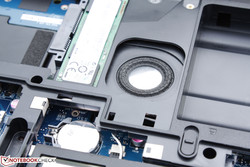
The built-in 2 Watt stereo speakers and subwoofer provide very good sound quality. Maximum volume is very loud, but unfortunately loses a bit of balance at high settings, so external 7.1 or Optical solutions are recommended to fill a living room. The bass is great at medium volume settings with enough power to feel the notebook reverberate when watching movies and listening to music.
The Sound Blaster X-Fi3 software is still one of our favorites as its UI and options are better than the Dolby Digital interface found on many other gaming models.
Battery Life
Pairing a 65 W CPU with a 100 W GTX 980M and no Optimus will naturally lead to horrendous battery life. We were able to squeeze out just over 2.5 hours at the best of conditions when idling on minimum brightness on the Power Saver profile. Runtimes are shorter during WLAN or gaming use, but only by an hour or so at most.
Compared to competing 17.3-inch gaming models, the removable 82 Wh Li-Ion battery pack is slightly smaller in capacity. The battery for the Alienware 17 R2, for example, holds almost 20 percent more energy. Benefits from having Optimus are clearly seen in our comparison table below.
| Eurocom P7 Pro 82 Wh | Asus G751JY-T7009H 88 Wh | Alienware 17 R2 96 Wh | MSI GT72-2QE32SR311BW 87 Wh | Gigabyte P37X 76 Wh | |
|---|---|---|---|---|---|
| Battery runtime | 28% | 179% | 69% | 61% | |
| Reader / Idle (h) | 2.7 | 4.5 67% | 12.2 352% | 6.6 144% | 5.5 104% |
| WiFi v1.3 (h) | 2.4 | 4 67% | |||
| Load (h) | 1.6 | 1.4 -12% | 1.7 6% | 1.5 -6% | 1.8 13% |
| WiFi (h) | 3.7 | 5.8 | 3.1 |
Pros
Cons
Verdict
We can comfortably say that the Eurocom P7 Pro is the best 17.3-inch gaming notebook in terms of raw performance and features. You can't really find a notebook elsewhere with a standard LGA1150 socket, MXM 3.0b slot, and PCIe x4 expansion all in one package. Its respectable CPU overclocking potential, excellent Boost performance, and customizable fan controls are just gravy on an otherwise solid Clevo platform. Tinkerers and enthusiasts need not look elsewhere for end-user customization and expandability.
Meanwhile, the new Core i7-5775C outperforms the current i7-4980HQ mobile champion by a good margin in multi-core benchmarks and its wide overclocking headroom allows it to come quite close to the much more power-hungry Core i7-4790K.
There is room for improvement, such as adding dedicated Macro keys, additional legacy ports, and higher capacity battery options. The 1080p display is great, but it isn't as impressive as the rest of the notebook. The short battery life and loud fan noise when gaming are also obvious drawbacks for a system in this category. Even so, these are just minor complaints for an otherwise excellent, stable, and expensive gaming system.
We can comfortably say that the Eurocom P7 Pro is the best 17.3-inch gaming notebook in terms of raw performance and features.
Eurocom P7 Pro
- 06/10/2015 v4 (old)
Allen Ngo




